Anyone who has visited Tuscany during the summer has surely already heard of the Palio di Siena. It is indeed the most famous historical horse race in Italy. Although it is not an event organised to attract tourists, if you are on holiday nearby, you absolutely cannot miss it! Find out everything you need to know about the Palio di Siena 2025 with us.
During your stay in the city for the Palio, you could also embark on a magnificent tour to discover Siena Cathedral and its splendid masterpieces with the ticket reserved for you by Visit Italy.
Visit Siena Cathedral with a marvelous tour
What is the Palio di Siena?
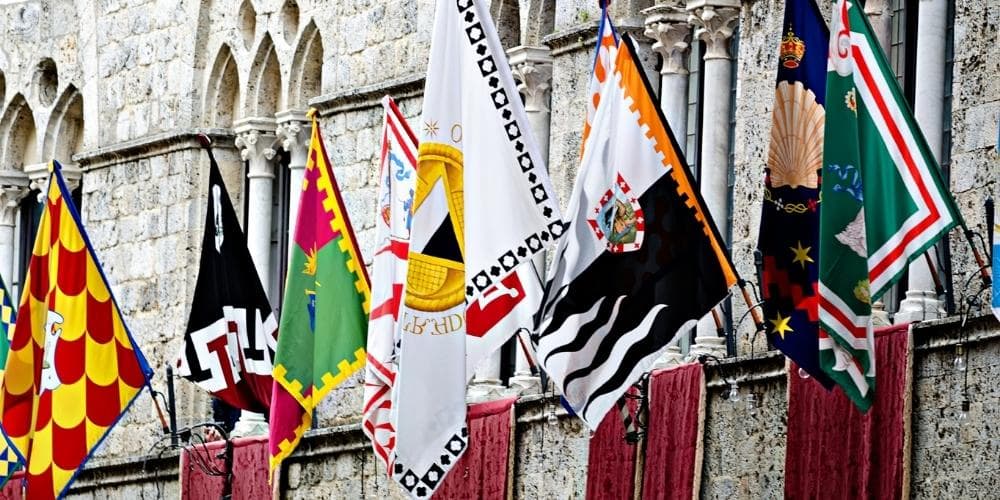
The flags of the Contrade
As its very name suggests, the Palio is held in Siena, Tuscany. It is an annual event, the most deeply felt by the local population. It is held on the dates of 2nd July and 16th August.
This spectacular Palio in Italy consists of a horse race, held in Piazza del Campo, in the historic centre of Siena. On this occasion, the various Sienese Contrade, i.e. the areas into which the city is divided, compete for victory. Siena is in fact composed of no less than 17 Contrade, namely: Aquila, Bruco, Chiocciola, Civetta, Drago, Giraffa, Istrice, Leocorno, Lupa, Nicchio, Oca, Onda, Pantera, Selva, Tartuca, Torre, Valdimontone.
Each Contrada has its own coat of arms, distinguished by its colours. If, for example, you walk through town and notice a yellow and turquoise coat of arms, it means you are in the Contrada of the Tartuca. White and red are instead the colours of the Giraffa, yellow and red with turquoise lists those of the Chiocciola, and so on.
The history of the Palio di Siena has its roots in rather remote times. In fact, we know that the event took place as early as the 17th century. It is therefore a very important tradition for the inhabitants of the city: the contradaioli have participated in the life of the Contrada since childhood, working hard all year round in preparation for the Palio. This transport is very contagious and even those who are in town for a visit will certainly be involved.
How the Palio takes place and Palio di Siena tickets

Piazza del Campo on the day of the Palio
Would you like to know what to do in Siena like a local? As we have seen, the Palio di Siena is not a simple horse race because it symbolises the pride and centuries-old culture of the Sienese people. The event involves a large number of rules, customs and practices, which the contradaioli know perfectly well. Knowing them in advance also allows tourists to better understand the unfolding of the event and enjoy it more.
Palio di Siena tickets: the first thing to know is that there is no accredited ticket office for the Palio. So how to participate? One has to contact the stage managers, the so-called palcaioli. The alternative is to get to know some of the tenants of the houses that overlook the Piazza del Campo.
The race, known as ‘Carreer’, is held on two dates to celebrate two religious festivities that are heartfelt by the Sienese population. The first day is dedicated to Our Lady of Provenzano, on 2nd July, and is therefore called the Palio di Provenzano, and is held from 29th June to 2nd July. The second instead is in honour of the Assumption of Mary, on 16th August, and is called the Palio of the Assumption, held from 13th to 16th August.
Only 10 of the 17 Sienese Contrade are allowed to take part. But which ones? The first 7 are those that did not run in the previous Palio. The remaining 3 are drawn during the day of the Tratta, i.e. three days before the actual race. On this occasion, the horses are also assigned to the various Contrade.
The rehearsals of Palio of Siena and the Dinner of the Dress Rehearsal
On the first day of the celebation, the marking of the horses takes place, they gather in so-called batteries, and rehearsals are held. The captains and the mayor decide which horses will compete for the coveted Palio. After the Assignment, which matches the horses to their respective contrade, the barbarian takes delivery of the horse and leads it to the stable.
In addition to the race, the spectacular Palio di Siena features numerous choreographies that contribute to making it evocative and fascinating. One of them is the Historical Procession, which celebrates the institutions, the sacredness of the ancient contrade, and the glory of the Republic of Siena. On the third day, the Rehearsal takes place with the charge of the 4th Regiment of the Carabinieri from Rome, who parade on horseback before the arrival of the Historic Procession. In the evenings, the City Quarters hosts the Dinner of the Dress Rehearsal, which has a propitiatory value. The table of honour is reserved for the mayors, the jockey, and the City quarter leaders.
During the days of the rehearsals, the district dwellers organise numerous dinners in the festive districts to celebrate the happy, adrenalin-filled days of this important and eagerly awaited occasion. The Dinner of the City quarters, chosen as the topic of the Tucci in Italy series, also represents a symbolic moment of identity and pride in the community, which shares the values of tradition.
The day of the Palio
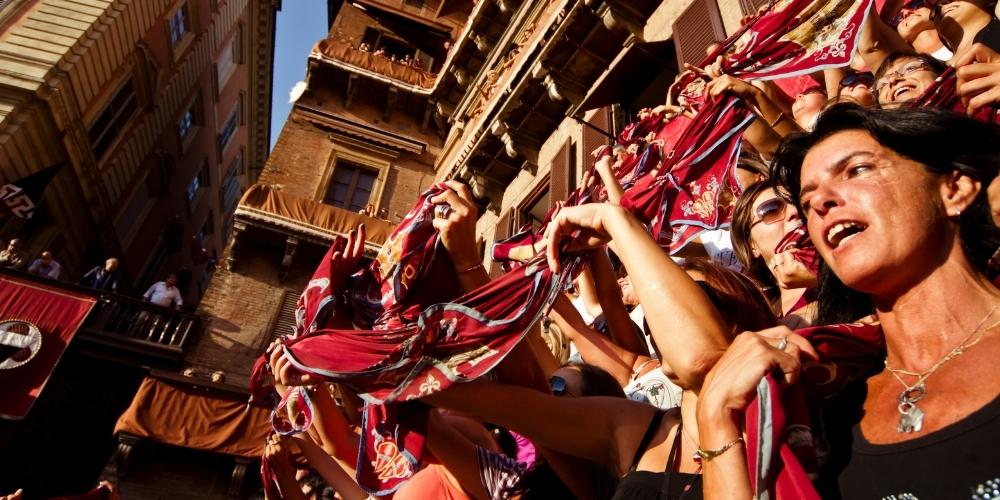
The Palio audience
Like any self-respecting event, the Palio di Siena includes a large number of activities and events. The festive day already opens at 8 a.m. at the chapel next to the Palazzo Comunale, for the celebration of the jockey's mass, “Messa del Fantino”. This is followed by the last of the various trial races (started in the previous days), known as 'la provaccia'.
At 10.30 a.m., again at the Town Hall, the “signing of the jockeys” takes place in the presence of the Mayor. This means that, from then on, no rider can be replaced.
The event continues at 3 p.m. when the blessing of the horses and jockeys takes place at the Contrade. This rite is followed by a large historical procession, in which more than 600 participants participate. It makes its way from the Palace of the Prefecture to the Square, parading cadenced by the rollers of the Passo della Diana on the notes of Pietro Formichi's Marcia del Palio.
One of the highlights of the procession is the passage of the Carroccio, the triumphal chariot of the prestigious Sienese Republic, which presents the Palio, the precious silk banner.
The procession ends around 18:30 in Piazza del Campo. A firecracker burst is the signal for the horses to leave, which pass through the so-called Entrone, the courtyard of the podestà.
The starting point of the race is the Mossa, a part of the square marked with ropes. This is where the Mossiere is located, i.e. the person who calls the Contrade in the order of the draw, making sure that there are no infringements. The first 9 Contrade are placed in order. The last remaining one, the tenth, enters after the draw: this is the signal for the start of the race.
It can happen, however, that the start is not valid. This happens if, for example, the jockeys do not respect the assigned position. If this happens, you have to start all over again! This is a real stage of the Palio, which can last a very long time.
The race
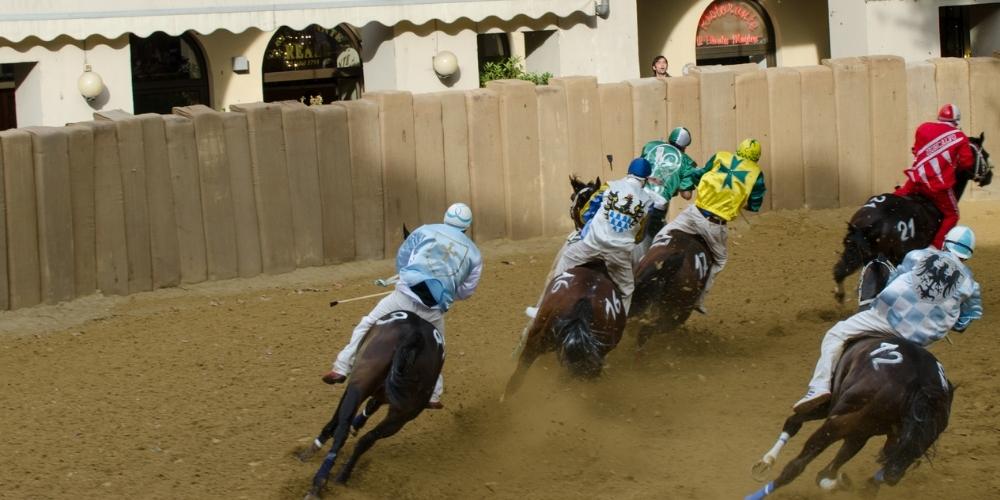
Horses running at the Palio
Once a valid start has been obtained, the Palio di Siena race begins. The horses have to run three laps of the square, trying to outdo each other in every way. There is no shortage of clashes, especially at the very tight San Martino bend.
The winner is the first horse to cross the finish line - with or without a jockey in the saddle! This determines the winning Contrada, to which the coveted prize is awarded: the Drappellone, a canvas painted from year to year by different artists.
The Palio di Siena winner 2024 was the City quarter of the Wave, whereas the City quarter of the Wolf won the Palio of the Assumption.
Useful tips for attending the Palio

The Palio di Siena procession
You can watch the Palio di Siena race free of charge by reaching Piazza del Campo. In this case, it is advisable to get in at 16:30 at the latest. Those who wish to secure a place at the colonnini, i.e. at the edge of the track, will have to arrive even earlier: these are usually already occupied in the morning!
There is also the possibility of booking paid seats in the grandstands or on the balconies overlooking the square. In this case, we advise you to contact the APT of Siena. If, on the other hand, you wish to fully immerse yourself in the local atmosphere, you can contact the owners of the houses: they will not fail to offer you a taste of typical Sienese sweets!
Palio of Siena 2025
On 25th May, the city quarters that will compete in the final of the Palio dedicated to Our Lady of Provenzano, which will take place on 2nd July 2025, were drawn. It's one of the events not to be missed in Italy in July. The contestants Lupa, Bruco, Oca, Pantera, and Valdimontone are the participants who will complete the career in addition to Tartuca, Drago, Chiocciola, Istrice, and Selva, who will take part by right. The Palace Trumpets marked the beginning of the drawing ceremony, and the Captains presented the appointment of the Mossiere to the municipal administration.
The flags of the contenders were displayed at the three-part windows on the first floor of the monumental, iconic, and elegant Pubblic Palace. The flags of the non-chosen city quarters were hoisted on the second floor next to those of the disqualified.
The artist Riccardo Manganelli, who won the competition organised to choose the artist, was entrusted with the task of painting the blazoned Drappellone for the Palio di Siena 2025.
About the author
Written on 22/06/2022

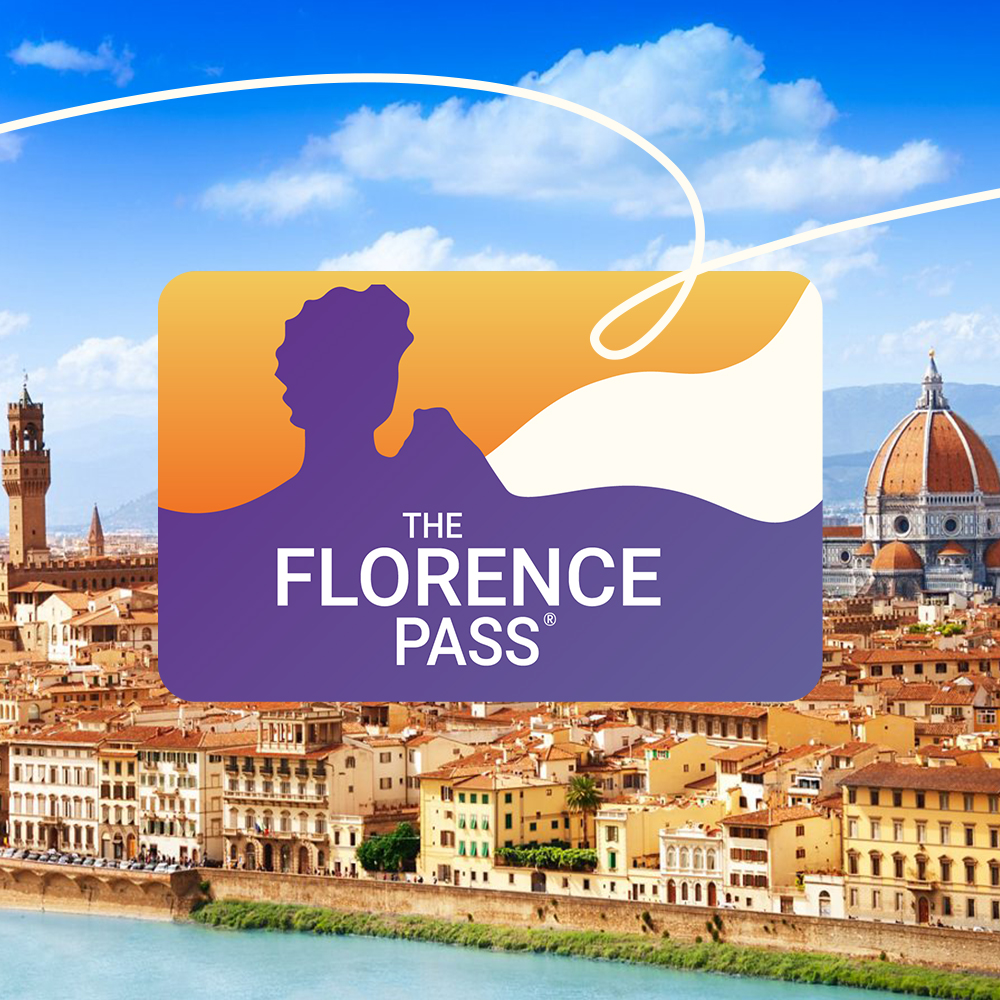
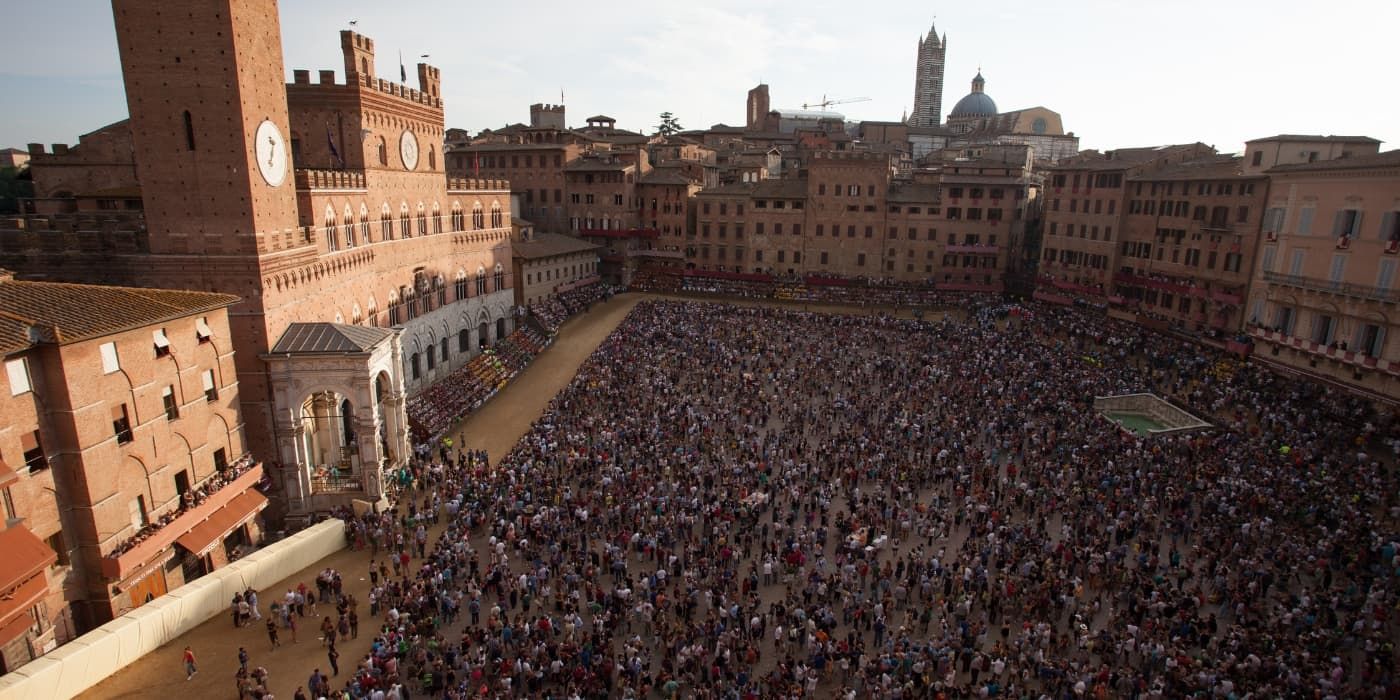

Martina Guelfi
What would summer in Tuscany be without the Palio di Siena? Discover with us all the secrets of Italy's most famous historic horse race 2025.